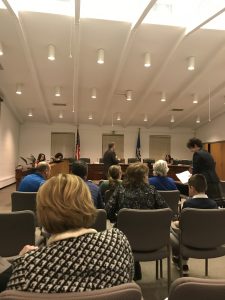Tool for Change: Understanding the Formation and Evolution of the Title IX Statute as a Policy Base for Social and Political Reform
In the United States, upward social mobility is often desired but infrequently achieved due to inequalities within political, economic, and social structures. The United States places a strong emphasis on academic rigor to achieve upward social mobility. Educational opportunities are crucial for the success of American citizens because the United States has strong cultural reliance on schooling, literacy, and a competitive nature with other nations. The United States has deeply rooted history within the system of education, however, there are large disparities within educational opportunities. The United States is continuously challenged to combat educational disparities through top-down methodology. Policymakers, advocates, and citizens rally to create legislation to challenge educational inequalities. Often, legislators develop policy to challenge one issue, however, the policy in practice can be much different. Furthermore, legislators use the momentum of particular policy as a tool for change; to create political and social reform from policy enacted by Congress. Specifically, the implementation and evolution of the educational statute, Title IX, suggests that the role of institutional legitimacy within government and academic institutions directly correspond to momentum shift of policy in practice. The evolution of Title IX shows two different political bases in which legislators used the statute Title IX as a tool for change to instill social and political reform. How did the Title IX statute originate in 1972 as a matter of educational policy in the minds of legislators and how has the policy shifted momentum in the past 15 years?
Throughout the early-to-mid 1900s, there were large social and economic disparities between men and women. In the educational realm, men had plethora of educational opportunities and women did not. This educational disparity between men and women received push-back by women’s rights activists. Legislators were forced to create a statute that would address the need for equal educational opportunities. The creation of the Title IX statute in 1972 sought to answer the concerns of activists. Interestingly, the momentum of Title IX has shifted from ensuring educational opportunities regardless of sex and has begun to address more pressing issues of sexual misconduct within post-secondary institutions. The shift in momentum functions through legislators using different issues as policy bases. Title IX originated as a matter of policy to strictly provide gender equality in educational opportunities using the policy base of athletics, however, within the past fifteen, legislators shifted momentum by addressing sexual misconduct as their policy base under Title IX to instill institutional legitimacy at the educational and governmental level to create meaningful social and political reform.
The development of educational equality as a matter of policy formation stems from the advocacy of women’s rights activists and the role of athletics in the mid 1900s. On July 2, 1964, Congress enacted the Civil Rights Act which “prohibited discrimination in public places, provided for the integration of schools and other public facilities and made employment discrimination illegal [on the basis of race, color, religion, sex or national origin]” (Bowen, 2015). This legislation was one of the first significant steps to eliminate discriminatory practices in the workplace on the basis of sex. After implementation, women’s rights activists continued to push for equalities within all aspects of American society. Studies found that educational opportunities were directly linked to greater participation in the labor force, increased earnings, better health and access to healthcare (Ensuring Equity, 2009, 4). Educational opportunities provide the necessary tools for upward social mobility. Therefore, activists understood the importance of institutions providing equal educational opportunities regardless of gender. Women’s rights activists also placed emphasis on the role of women in athletics.
Athletics have remained a dominant part of American culture. Women have been able to participate in athletics since the early 1900s. One of the main actors within athletics is the National Collegiate Athletic Association (NCAA). This organization was established in 1905 and remained the most dominant organization in intercollegiate athletics because of their administrative and organizational role and control of television rights for collegiate sports (Ware, 2011, 54). It is important to understand the role of the NCAA in the athletic realm of post-secondary institutions because the NCAA did not support the opinion of women’s rights activists in the need for equal educational and athletic opportunities. During the early 1900’s, the NCAA strictly focused on men’s athletic events due to popularity. However, during the 1960s, the United States Cold War rhetoric against the Soviet Union created “a palpable national need to defeat the Soviets in many areas of life, including sports” (Smith, 2011, 143). The emphasis of women competing in athletics shifted the viewpoint of the NCAA and the organization quickly embedded its administrative power in both male and female collegiate athletics. The advocacy of equal educational opportunities from women’s rights advocates and dominant organizations like the NCAA led to the implementation of the Title IX statute and created the first political base in which legislators strove to provide social and political reform.
Due to the determination of advocates of equal opportunity in educational and athletic structures within institutions, policymakers realized the need to create legislation to support gender equality. The United States enacted the federal statute Title IX under the Educational Amendment of 1972. Title IX states:
No person in the United States shall, on the basis of sex, be excluded from participation in, denied the benefits of, or be subjected to discrimination under any educational program or activity receiving federal financial assistance (AAUW, 2009).
The statute was fairly minor in terms of detail because legislators feared public push-back. The social norms within the United States still emphasized the gender differences between men and women. Legislators did not want radical policy, but quite simply, gender equality in education. After the passage of Title IX, there was a lack of enforcement in post-secondary educational institutions. Advocates accepted that Title IX was a tool in the process of achieving gender equality within educational and athletic opportunities. The strength of Title IX relied on its use of “citizens making educators aware of its existence and demanding adherence to this law” (Women Studies Newsletter, 1974). Self-advocacy was predominant in the athletic realm of Title IX and equal opportunity.
In 1976, the Yale women’s rowing team experienced conditions that were drastically different from their male counterpart. The women’s team were forced to sit on the bus, freezing cold, while the men’s team showered. Chris Ernst, an athlete on the women’s rowing team, and her eighteen other teammates made a nationwide stance against the unfair treatment. Ernst reached out to national media outlets to gain coverage of the unfair treatment that was still occurring even after the implementation of Title IX (Dupont, 2012). Policymakers needed to address higher educational institutions regarding their compliance with Title IX. Using athletics as the political base to instill political and social reform, legislators shifted the momentum of Title IX within the ten years of being implemented. This momentum shift in policy gave administrative power to educational institutions as well as government organizations. The Department of Health, Education and Welfare were given “three main responsibilities in administering Title IX: 1) explaining the law to schools and colleges and advising the public of its rights under the law and what to do if those rights were denied; 2) investigating charges of discrimination filed by citizens; and 3) initiating investigations to make sure the nation’s 16,000 school districts were in compliance with the law” (Smith, 2011, 63). Legislators quickly recognized the difficulty in administering the statute without real compliance guidelines. This lead to the creation of the Three Prong Test under the Title IX statue.
In 1979, the Office for Civil Rights created regulations in which an institution could adhere to Title IX requirements. Legislators used athletics as their political base to create guidance standards. In order to remain in compliance of Title IX, institutions could adhere to any one of the prongs including: “1) by providing athletic opportunities proportionate to student enrollment, (2) by demonstrating continual expansion of athletic opportunities to the underrepresented sex, and (3) by full accommodation of the interests and abilities of the underrepresented sex” (Smith, 2011, 149). The creation of the Three Prong Test instilled more institutional legitimacy at the governmental level because the government had a written set of compliance standards educational institutions were required to follow.
Within the first decade of Title IX, it was clear that Title IX originated as a matter of policy to address inequalities within educational institutions. Legislators created simple policy using athletics as their political base in the hopes to provide gender equality in educational opportunities. In the early stages of Title IX, there was a lack of enforcement due to the low level of legislative interest. However, the role of athletics acted as the policy base in which Title IX quickly shifted momentum over the first few years of implementation. The advocacy of women in athletics evolved Title IX to become more structurally sound; policymakers realized they needed to hold institutions accountable through the use of compliance guidelines like the Three Prong test. It is clear that the introduction of Title IX was to address the overarching disparities between men and women in regard to educational opportunities. However, in the past fifteen years, the evolution of Title IX has shifted to address the frequency of sexual misconduct on college campuses. Legislators are using sexual misconduct as the base under the Title IX statute to provide clear and precise legislative policy that will instill institutional legitimacy at the educational and governmental level.
Sexual misconduct is a societal issue that has been present in the United States for a very long time. However, within the past fifteen years, the United States has experienced an increase of sexual misconduct on college campuses. The evidence is overwhelming: 1-in-5 women experience sexual misconduct as some point during their college career (Gray, 2015). In addition, there has been a drastic rise of complaints of discrimination to the Office of Civil Rights (OCR) department from 6,364 in fiscal 2009 to 9,989 in fiscal 2014 (Layton, 2015). The increase of sexual misconduct within post-secondary institutions have created a significant momentum shift in Title IX policy. Legislators have shifted their political base from athletics to sexual misconduct in order to create relevant social and political reform. In 2011, the Obama administration issued the “Dear Colleague Letter” which offered guidance to institutions when handling sexual misconduct on college campuses.
The Dear Colleague guidance placed emphasis on procedural requirements of the college institution which included: “1) a notice of nondiscrimination, 2) employment of at least one individual to handle Title IX responsibilities at that institution and, 3) creation and publication of grievance procedures that provide a fair and timely response to sex discrimination complaints” (OCR, 2011, 6). The implementation of these procedural requirements under Title IX are the first momentum shift of Title IX policy under the political base of sexual misconduct. By creating these standards, the Obama administration initiated the efforts to instill institutional legitimacy at the governmental and educational level in order to address the high frequency of sexual misconduct on college campuses. The Obama administration used the Title IX statute as their base for their policy formation surrounding the prevalence of sexual misconduct on college campuses. The new guidance under the Title IX statute clearly had one focus in the mind of policymakers: to reduce the frequency of sexual assault on college campuses and to promote the use of educational programs when training students and faculty. However, the Obama administration failed to recognize the potential implications that arise from the implementation, applicability, and compliance standards of Dear Colleague.
After the release of the Obama administration “Dear Colleague” guidance, there was severe push-back from institutions and advocates due to confusing requirements and the governments “improper pressure upon universities to adopt procedures that do not afford fundamental fairness” (Penn, 2015, 1). The guidelines placed pressure on the collegiate institutions to adjudicate sexual assault cases, however, many argued this would sidestep due process and normal legal procedure. In addition, the 2011 “Dear Colleague” guidance acted as just that; there was no law passed by Congress to actually require institutions to reform their procedures. The government could do little to require institutions to comply with the guidance which reduced institutional legitimacy at both the governmental and institutional level. These push-backs created the most recent evolution of Title IX policy with the release of the Trump administration 2017 “Dear Colleague” guidance.
Once again, legislators must look to create meaningful policy that will create social and political reform. Due to societal pushback from the Obama administration “Dear Colleague” guidance, legislators have been forced to re-evaluate the policy guidelines under Title IX. In 2017, under the Trump administration, the Department of Education reverse and reintroduced the “Dear Colleague” guidance. The Department of Education Secretary, Betsy Devos, delivered new guidance referencing the importance of an equal and fair adjudication process for both the complainant and alleged perpetrator. The Department of Education believes that “many schools have established procedures for resolving allegations that lack the most basic elements of fairness and due process, are overwhelmingly stacked against the accused and are in no way required by Title IX law or regulation” (Jackson, 2017, 2). It is clear that the former adjudication process within educational institutions lack institutional legitimacy that is needed to create lasting social and political reform to combat sexual misconduct. Most recently, the Trump administration is providing viable options to instill institutional legitimacy. The Department of Education recommend that the adjudication process be handled by a third-party representative, to remove the sixty-day mandatory resolution deadline, increase the standard of proof to clear and convincing, and to require institutions to provide legal support (Brown, 2017). These guidelines will instill institutional legitimacy at the educational and governmental level because the institutions will be able to provide meaningful support and a fair adjudication process in sexual misconduct cases. Creating institutional legitimacy at the educational and governmental level under the Title IX statute allows legislators to instill lasting social and political reform to address sexual misconduct.
Overall, the formation of policy is often much different than policy in practice. The introduction of Title IX in 1972 was merely to provide equal educational opportunities regardless of sex. During the mid-to-late 1900s, legislators used athletics as their policy base to implement regulations and procedures to better equip educational and governmental institutions with strategies to challenge inequalities within the education sector. Within the past fifteen years, legislators have shifted the momentum of Title IX by using the issue of the frequency of sexual misconduct on college campuses as their policy base. Through “Dear Colleague” guidelines issued by the Obama administration and Trump administration, it is clear that legislators are using a different policy base to create meaningful social and political reform. Although the policy base has shifted momentum from the formation of Title IX to present-day, legislators believe in the importance of institutional legitimacy and their reform efforts show that precise legislation and a fair adjudication process will instill institutional legitimacy at the educational and governmental level. In order for Title IX policy to benefit society, the policy must be equip to provide necessary components to combat inequalities within educational institutions. Institutional legitimacy will allow Title IX to function as its intended purpose; to provide equal education opportunities regardless of sex.
Works Cited
Bowen, Mae. “This Day in History: President Lyndon B. Johnson Signed the Civil Rights Act of 1964.” National Archives and Records Administration, National Archives and Records Administration, 2 July 2015, obamawhitehouse.archives.gov/blog/2015/07/02/day-history-president-lyndon-b-johnson-signed-civil-rights-act-1964.
Brown, Sarah. “What Does the End of Obama’s Title IX Guidance Mean for Colleges?” Chronicle.com, The Chronicle of Higher Education, 23 Sept. 2017, www.chronicle.com/article/What-Does-the-End-of-Obama-s/241281.
Office for Civil Rights. Dear Colleague . United States Department of Education, 4 Apr. 2011.
Office for Civil Rights. Dear Colleague . United States Department of Education, 7 Sept. 2017.
Dupont, Kevin. “Former Yale Rower Chris Ernst to Be Honored for Forcing Changes in Women’s Athletics – The Boston Globe.” BostonGlobe.com, 17 June 2012, www.bostonglobe.com/sports/2012/06/16/former-yale-rower-chris-ernst-honored-for-forcing-changes-women-athletics/67fjt0fIH8lJ6Oy3bE7KmL/story.html.
Gray, Eliza. “Sexual Assault: University Survey Highlights Role of ‘Verbal Coercion’.” Time, Time, 25 June 2015, time.com/3936005/university-michigan-sexual-misconduct-survey/.
Jackson, Candice. “Dear Colleague.” United States Department of Education, Office of Civil Rights, 22 Sept. 2017, www2.ed.gov/about/offices/list/ocr/letters/colleague-title-ix-201709.pdf.
Layton, Lyndsey. “Civil Rights Complaints to U.S. Department of Education Reach a Record High.” The Washington Post, WP Company, 18 Mar. 2015, www.washingtonpost.com/news/local/wp/2015/03/18/civil-rights-complaints-to-u-s-department-of-education-reach-a-record-high/?utm_term=.e0e44f082bf7.
Penn Law School Faculty. Sexual Assault Complaints: Protecting Complainants and the Accused Students at Universities. Penn Law School, 18 Feb. 2015.
AAUW Public Policy and Government Relations Department. Title IX: Ensuring Equity in Education for Women and Girls. June 2009.
Reynolds, Celene. “The Mobilization of Title IX in Colleges and Universities.” Institution for Social and Policy Studies, Yale University, 17 May 2016, isps.yale.edu/news/blog/2016/08/the-mobilization-of-title-ix-in-colleges-and-universities.
Smith, Ronald A. “Title IX and Governmental Reform in Women’s Athletics.” Pay for Play: A History of Big-Time College Athletic Reform, University of Illinois Press, 2011, pp. 141–150. JSTOR, www.jstor.org/stable/10.5406/j.ctt1xckxq.19.
Ware, Susan. “In the Meantime: THE EARLY DAYS OF TITLE IX.” Game, Set, Match: Billie Jean King and the Revolution in Women’s Sports, University of North Carolina Press, 2011, pp. 43–74. JSTOR, www.jstor.org/stable/10.5149/9780807877999_ware.5.
“Title IX: A Tool for Change.” Women’s Studies Newsletter, vol. 2, no. 1, 1974, pp. 13–13. JSTOR, JSTOR, www.jstor.org/stable/40041889.





